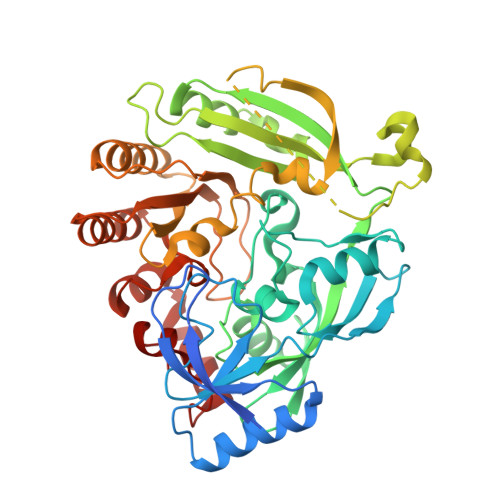Structural basis of inhibition of Mycobacterium tuberculosis DprE1 by benzothiazinone inhibitors.
Batt, S.M., Jabeen, T., Bhowruth, V., Quill, L., Lund, P.A., Eggeling, L., Alderwick, L.J., Futterer, K., Besra, G.S.(2012) Proc Natl Acad Sci U S A 109: 11354-11359
- PubMed: 22733761
- DOI: https://doi.org/10.1073/pnas.1205735109
- Primary Citation of Related Structures:
4FDN, 4FDO, 4FDP, 4FEH, 4FF6 - PubMed Abstract:
Resistance against currently used antitubercular therapeutics increasingly undermines efforts to contain the worldwide tuberculosis (TB) epidemic. Recently, benzothiazinone (BTZ) inhibitors have shown nanomolar potency against both drug-susceptible and multidrug-resistant strains of the tubercle bacillus. However, their proposed mode of action is lacking structural evidence. We report here the crystal structure of the BTZ target, FAD-containing oxidoreductase Mycobacterium tuberculosis DprE1, which is essential for viability. Different crystal forms of ligand-free DprE1 reveal considerable levels of structural flexibility of two surface loops that seem to govern accessibility of the active site. Structures of complexes with the BTZ-derived nitroso derivative CT325 reveal the mode of inhibitor binding, which includes a covalent link to conserved Cys387, and reveal a trifluoromethyl group as a second key determinant of interaction with the enzyme. Surprisingly, we find that a noncovalent complex was formed between DprE1 and CT319, which is structurally identical to CT325 except for an inert nitro group replacing the reactive nitroso group. This demonstrates that binding of BTZ-class inhibitors to DprE1 is not strictly dependent on formation of the covalent link to Cys387. On the basis of the structural and activity data, we propose that the complex of DrpE1 bound to CT325 is a representative of the BTZ-target complex. These results mark a significant step forward in the characterization of a key TB drug target.
- School of Biosciences, University of Birmingham, Edgbaston, Birmingham B15 2TT, United Kingdom.
Organizational Affiliation:


















